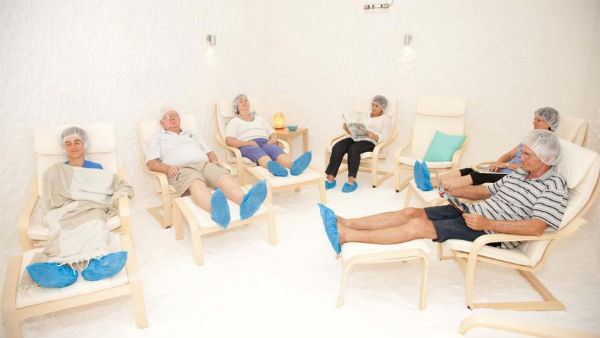Salt room therapy is one of the newer alternative therapies that is rapidly gaining popularity for all the right reasons. It is based on the principle that direct exposure to the right amount of salt helps in rejuvenating all the body tissues. It is part of dry salt therapy and has been used successfully to treat several disorders.

Salt room therapy is inspired by an ancient form of therapy that originated in Poland. People used to visit caves that were known to have a good amount of salt deposits. Exposure to salt helped them get rid of several ailments. There are several spas and health resorts all over Europe, America and Asia offering salt room therapy.
Health Benefits of Salt Room Therapy for Patients
Some of the health benefits of salt room therapy are mentioned below:
Respiratory System:
Salt room therapy is said to be the most beneficial, for treatment of respiratory disorders. Patients suffering from asthma, COPD, asbestosis, experienced considerable improvement in their symptoms after regular sessions of salt room therapy.

Exposure to dry air laced with salt helps in drying up the unhealthy secretions of lungs and bronchial tubes. This is one of the major benefits of salt room therapy for lung ailments.
Nervous System:
Salt room therapy is known to have a rejuvenating effect on tired and fatigue ridden nerves. Many people who need a break from their daily grind opt for a session of salt room therapy and come back refreshed.

Salt particles help in stimulating nerves to conduct electrical impulses better and leave the patient feeling energetic. Salt room therapy is also known to have beneficial effects in curbing headaches of nervous origin, migraine, spinal nerve disorders etc.
Mental Health:
Exposure to salt and minerals stimulates energy levels and also enhances blood circulation to all body tissues. This helps in improving cerebral circulation and helps in maintaining healthier brain cells.
Patients battling depression have experienced great benefits from regular salt room sessions. Anxiety, sleep disorders, mood disorders are also known to benefit from this therapy.
Skin and Hair:
It is said that salt helps in balancing the moisture levels of skin. People undergoing salt room therapy get their skin directly exposed to salt. This allows the salt particles to repair dead and damaged skin and help to retain the required amount of moisture.

Health conditions like psoriasis, eczema, dermatitis respond very well to salt room therapy. Salt has an anti bacterial effect which makes it an efficient cure for skin infections. Aside from skin disorders, salt therapy also helps in cleansing the skin and making it healthier. People who opted for salt room therapy as part of rejuvenation, developed healthy, glowing and soft skin.
Salt is also known to have a beneficial effect on one’s immune system. It helps to control levels of IgE and thus helps in battling allergic responses. Salt is a known anti inflammatory agent. Therefore, salt therapy is also helpful for patients suffering from joint disorders, auto immune disorders etc.
Salt Room Therapy for Healthy People
Other than helping to treat several health disorders, salt room therapy is also known to provide a rejuvenating and relaxing experience. Many people who want a break from their daily grind, indulge in salt room therapy regularly. People have reported feeling fresh and more energetic by spending time in a salt room on a regular basis. Salt room therapy helps to get rid of mental stress, tired nerves, muscular soreness, which has become part of the daily fast paced life most people lead.
What is a Salt Room?
Salt room therapy is conducted in artificially built salt caves. Temperature controlled rooms are built in an attempt to simulate a sea side experience, minus the humidity. Floor of these rooms is layered with salt and salt is also introduced in the room through air vents. Due to absence of humidity, patients can can experience the benefit of dry salt therapy. The salt is usually imported from ancient caves in Poland known for their rich salt deposits or from Himalayas. The salt is then processed and refined before using it for therapy sessions.
A halogenerator is used in most of the spas offering salt room therapy. This device filters and spreads salt evenly into the salt rooms during therapy sessions. People can enjoy a relaxing session of dry salt therapy in one of these rooms for a time span of anywhere between 25-45 minutes. Salt therapy does not make use of chemicals, steroids or any artificial preparations. This makes is 100% safe with little possibility of side effects.
Limitations of Salt Room Therapy
Salt room therapy has proven to be beneficial since ancient times. People have been benefiting from it since as early as the 1800s. However, no scientific or medical experiment has been conducted to prove its efficacy. Therefore, this therapy has not received adequate recognition.
There is no documented evidence of salt therapy proving to be beneficial in every patient. The therapy cannot replace medical or surgical treatment completely. It has to be used in conjunction with main stream treatment. While ancient proofs and documents exist about how salt therapy was discovered and used, there is no proof of any recent study being done for the same.
Contraindications of Salt Room Therapy
While salt room therapy is impressing one and all across the globe, it may not be helpful for everyone. Certain health conditions may contradict the use of salt room therapy.
Pregnant women should not undergo this therapy; especially if they have been battling blood pressure issues. It is also inadvisable for patients with cardiac disorders to opt for this therapy. While salt room therapy has proven to be beneficial in case of respiratory ailments, it should be avoided during acute exacerbations of symptoms. Patients who have recently suffered from burn injuries, should also refrain from undergoing salt room therapy as it may irritate the skin.
Salt room therapy should be chosen as a treatment method, only if it has been approved by a qualified physician. This form of therapy is widely available in Europe, America and parts of Asia.